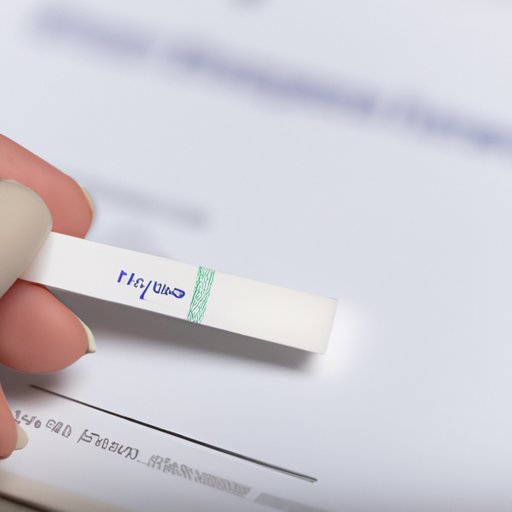
Introduction
Lyme disease is a tick-borne illness caused by the bacterium Borrelia burgdorferi. It can cause a wide range of symptoms, from joint pain and fatigue to neurological issues and heart problems. Testing for Lyme disease is crucial for patients to receive prompt and effective treatment. This article will provide a comprehensive guide to testing for Lyme disease, including different testing methods and their pros and cons, as well as tips for at-home testing and early detection.
The Ultimate Guide to Testing for Lyme Disease – Everything You Need to Know
There are several different types of Lyme disease tests available, including the ELISA, Western Blot, and PCR tests. Each type of test has its own benefits and drawbacks.
The ELISA, or enzyme-linked immunosorbent assay, is the most commonly used test for Lyme disease. It detects antibodies produced by the body in response to the bacteria that causes Lyme disease. While the ELISA is sensitive, it may produce false positive results in patients who have been vaccinated for Lyme disease or who have had a previous Lyme disease infection. It is also less accurate during the early stages of the disease.
The Western Blot test is a more specific test for Lyme disease. It detects antibodies to specific proteins in the bacteria that causes Lyme disease. It is more accurate than the ELISA, but it may still produce false negative results during the early stages of the disease. It is also more expensive than the ELISA.
The PCR, or polymerase chain reaction, test detects the DNA of the bacteria that causes Lyme disease. While the PCR test is highly sensitive and can detect the bacteria even in the early stages of the disease, it is expensive and not widely available.
It is important to note that none of these tests are foolproof, and multiple tests may be necessary to confirm a Lyme disease diagnosis.
DIY Lyme Disease Testing – How to Test Yourself at Home
There are several at-home Lyme disease tests available, including tick testing, blood testing, and urine testing.
Tick testing involves sending a tick that has bitten a person to a laboratory, where it will be tested for Lyme disease. Blood testing involves using a kit to draw blood and send it to a laboratory for testing. Urine testing involves collecting a urine sample and sending it to a laboratory for testing.
It is important to note that at-home testing may not be as accurate as professional testing, and diagnosis should always be confirmed by a medical professional. It is also important to follow all instructions carefully and handle samples properly to avoid contamination or incorrect results.
The Importance of Early Detection – How to Test for Lyme Disease and What to Look for
Early detection of Lyme disease is crucial for effective treatment. Common signs and symptoms of Lyme disease include a bull’s-eye rash, fever, chills, headache, fatigue, muscle and joint aches, and swollen lymph nodes.
If you suspect you have been bitten by a tick or are experiencing symptoms of Lyme disease, it is important to seek medical attention as soon as possible. Your doctor may perform a physical exam and order one or more tests to confirm a Lyme disease diagnosis.
Lyme Disease Testing – What to Expect and How to Prepare
Different types of Lyme disease tests may require different preparation. It is important to follow any instructions provided by your healthcare provider carefully to ensure accurate results.
Blood tests typically do not require any special preparation. However, you may be asked to avoid certain medications or supplements that could affect the results of the test.
Tick testing typically involves mailing the tick directly to a laboratory. It is important to properly package the tick to avoid any contamination or damage during shipping.
Urine tests typically require collecting a clean-catch urine sample and may require avoiding certain foods or medications in advance.
Some patients may experience mild side effects from Lyme disease testing, such as bruising or soreness at the site of blood draw. In rare cases, more severe side effects such as infection may occur.
What You Need to Know About Lyme Disease Testing – A Comprehensive Overview for Patients
If you are considering Lyme disease testing, it is important to fully understand the testing process and your options. Talk to your healthcare provider about any concerns or questions you may have.
There are also resources and support available for Lyme disease patients, including advocacy organizations, support groups, and online resources.
The Pros and Cons of Different Lyme Disease Testing Methods – Which One is Right for You?
There are several factors to consider when choosing a Lyme disease testing method, including accuracy, cost, and availability.
Using a chart or diagram can be helpful in comparing and contrasting different testing methods. Ultimately, the best testing method for you will depend on your individual needs and circumstances.

How to Test for Lyme Disease – Advice from Medical Professionals and Patients
Medical professionals who specialize in Lyme disease testing and treatment can provide valuable insights and advice. It can also be helpful to hear stories and experiences from other Lyme disease patients who have gone through the testing process.
There are many resources available for those who want to learn more about Lyme disease testing and treatment, including medical organizations, advocacy groups, and academic research centers.
Conclusion
Testing for Lyme disease is a crucial step in receiving prompt and effective treatment. There are several different testing methods available, each with its own benefits and drawbacks. Whether you choose professional testing or at-home testing, it is important to follow all instructions carefully and seek medical attention if you suspect you have Lyme disease. By taking control of your health and staying informed about Lyme disease testing, you can help ensure the best possible outcome.





